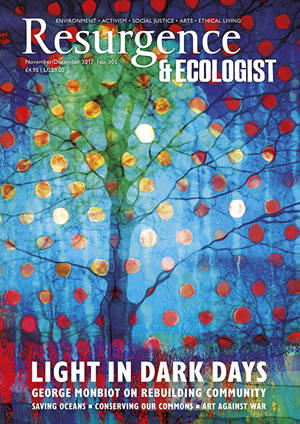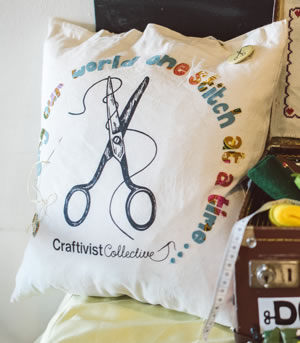There is so much loveliness in Nature, in people, in craft, in creativity. But I know that we can make it even more beautiful, and more kind and more fair. I have been an activist since I was three, but a few years ago I burned out and felt that I didn’t fit in. I was going to give up. Then I discovered I could use craft in my activism. I became a craftivist.
An effective craftivist is someone who channels their anger at injustice and their passion for a better world into creative objects and activities. Those crafted objects can then help play a part in tackling the root causes of injustice and help create long-lasting positive change.
I believe that the most effective way to be a craftivist is through the art of gentle protest. It’s a way that we can – alone or in a group – effectively protest against harmful structures, attract people to do likewise, and reflect on the way we want our world to be, challenging injustice and harm through values of love, kindness and humility. A gentle protest approach is in line with our goal of doing activism in a beautiful, kind and fair way that models the world we want to live in.
Craft materials and activities can be a social lubricant: when you are stitching alone on public transport, in parks or in cafés, people often ask what you are doing. In my experience, stitching a small craftivism object that has provocative words on the theme of social change can intrigue strangers often more than if words were not included. To harness this curiosity, once you notice they are watching you, smile and go back to stitching.
This technique offers a friendly ground for open discussion with no pressure attached. If people ask you what you are making, quietly show them, read them the message, explain what you are going to do with the object and ask them for their advice on where to put it to have the most impact. By ending with a question you are initiating a conversation on the issue you are questioning or protesting about.
Crafting creates a respectful safe barrier between you and the other person because it helps break eye contact to stop the conversation from being too aggressive or intense, and the craft materials in your hands keep you a safe distance away from each other so that you are not invading each other’s personal space.
My craftivism projects have included bunting, personalised handkerchiefs sent to high-ranking decision makers, and face masks placed on statues. You can also alter an object that is already well recognised and connects to many individual memories and cultural history.
I altered the look of a Barbie doll to address gender inequality. I used to regularly catch a train from Clapham Junction in south London to an office in Waterloo. On my way home I would often pass a group of teenage boys and girls hanging out on the steps at the back entrance of the station. They were not causing any bother, just socialising. I kept noticing that the lads would be quite loud and boisterous and the girls often said nothing or just giggled. The boys would have their arms around the girls and it made me think: did the boys feel they had to be confident and lead the conversations and did the girls feel they had to ‘sit pretty’ and not speak up? Maybe I was reading that into the situation, but I did want to address the gender inequality I thought I was seeing with a gentle protest approach.
I decided to create a striking image of a battered and bruised Barbie doll with tape over her eyes and mouth. She held a small placard with a message written on it to provoke this group and passers-by to think about and discuss the impact gender inequality has on all of our lives. I placed it near the group but not too close, and below eye level to intrigue people. Two lads came up and asked me what I was doing. I showed them and read out the handwritten message on the placard I had picked to encourage thought and conversation: “‘You can tell the condition of a nation by looking at the state of its women’ – Jawaharlal Nehru (1889–1964) First Prime Minister of Independent India”.
I asked them if they felt they had to be confident and ‘protectors’ of their girlfriends, maybe pay for everything for them, or whether they could just be themselves around girls and treat each other equally. We had a chat about the pressures they sometimes feel to be ‘the men’ and that they thought that girls probably did feel pressure to look pretty for them. I asked if they were OK with me leaving my Barbie doll for others to see. The response was, “Yeah, we’ll look after it.” The photograph has not only been published in numerous books and magazines, but also been shared over the years on blogs and social media, creating more discussions on gender equality.
To be a craftivist is not just to be someone who likes craft: it is to be someone who hones their craft to question injustice, encourage peace and show ways to achieve a better world for everybody involved. The test of whether we truly want a better world is in the doing – through action.
FEELING FRAYED
I will never forget the day I made an old lady cry. It wasn’t on purpose. It was years ago. I was in my home town of Liverpool, and the city’s first branch of a nowadays well-known cheap clothing store was just about to open. Surely, I thought, there should be a demonstration to show the true cost of many cheap clothes: sweatshops, undignified labour practices, low wages, abuse of garment workers and ‘fast fashion’ filling our landfills? I rallied a group of friends to set up a demonstration on its opening day. We made placards with facts on them about the pay, the number of hours worked and the treatment the garment workers received while making these clothes. Then I made an old lady cry.
She looked about eighty years old, very small and frail. She walked up to me from the shop with her large bag full of purchases. She asked me quietly with a wobbly voice if the information was true on our placards. I said that sadly it was and we should challenge the company to change their ways as well as shopping in more ethical shops. “Cheap clothes come with a big cost,” I said.
She whispered to me that it was one of the only places she could afford to shop, not just for herself but for her children and grandchildren. Her eyes started filling up; mine started filling, too. I had been so focused on getting our message out there in the public domain that I hadn’t thought about the different ways people might respond to our protest and the different reasons people might have for shopping at such a store.
Our demonstration had some positive results. We gave out all of the leaflets we had. The local newspaper and radio station mentioned our protest. More than 400 signatures were collected for our petition, which we handed over to the store manager at the end of that day. But I wasn’t sure that the type of demonstration we’d held was as effective as it could have been. I didn’t feel that we’d reached out to the people queuing up to go into the store, or to passers-by, in a way that allowed both ‘sides’ to listen to each other and converse. And I couldn’t stop thinking about the old lady who had cried when she learned about the chain’s unethical practices.
If I was going to deliver a protest outside that store again, I would do it differently. The message would be more intriguing, focusing on how we all need to slow down and take time to think about what we are doing and buying. Such companies should produce fewer new clothes so that they can be more careful in their production process, and we as consumers should enjoy the shopping process slowly: seeing what clothes we need and what will last – not giving in to quick impulses, but buying clothes we will cherish.
Craftivists could occupy a small but visually stimulating area visible near the store where we would make cakes to look like snails, and other craftivists would give them out with informative flyers. We would encourage friendly conversation about the importance of slow fashion not only to help tackle the ugly hidden sides of the fashion industry, but also for us to appreciate our clothes more. We would share images of these crafted snails and intriguing messages, encouraging people to find out more about the company’s production processes, to help them make informed consumer choices.
The old lady would then not be in tears, but encouraged and empowered to be part of the change she wishes to see in the world.







